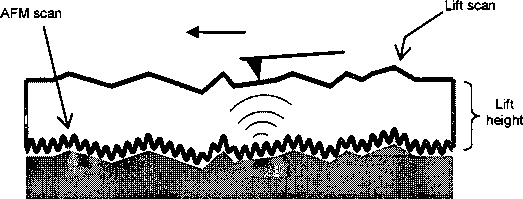charge densities of both the gel phase and the fluid phase be equal. We used Fluid
Electric Force Microscopy (FEFM) [45] to compare surface charge densities of the two
phases. FEFM involves the AFM scanning the sample topography, lifting the tip to a
predetermined lift height and rescanning the along the same contour, at the lift height (see
Figure 3.15). For flat samples, the force on the tip during the lift scan is directly
proportional to the samples surface charge density. Thus using FEFM we get a
simultaneous topography and charge contrast map.
F ∞ °sample

Figure 3.15: Schematic of Fluid Electric Force Microscopy (FEFM). The force F
experienced by the tip during the lift scan is directly proportional to the samples surface
charge density σsampie.
44
More intriguing information
1. Technological progress, organizational change and the size of the Human Resources Department2. The storage and use of newborn babies’ blood spot cards: a public consultation
3. Strategic Investment and Market Integration
4. Developmental changes in the theta response system: a single sweep analysis
5. AMINO ACIDS SEQUENCE ANALYSIS ON COLLAGEN
6. The Variable-Rate Decision for Multiple Inputs with Multiple Management Zones
7. Density Estimation and Combination under Model Ambiguity
8. Income Growth and Mobility of Rural Households in Kenya: Role of Education and Historical Patterns in Poverty Reduction
9. Neural Network Modelling of Constrained Spatial Interaction Flows
10. Les freins culturels à l'adoption des IFRS en Europe : une analyse du cas français